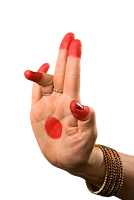Ten Asanjukta Mudra and Their Uses&Head circulation dance
Ten Asanjukta Mudra and Their Uses&Head circulation dance
The application of 10 unconnected mudras out of a total of 28 unconnected mudras in Natya Shastra is discussed below.1) Pataka - If the fingers are spread evenly over each other and the thumb is folded, it is the flag mudra.
2)Tripataka - When the ring finger is folded on the flag hand it is tripataka.
Uses:- In the sense of holding a crown, tree, thunderbolt, lamp, entering, saying goodbye, bowing etc.
3) Ardhapataka - Tripataka is Ardhapataka if the lower fold is folded in the hand.
4)Kartrimukha - If Ardhapataka is held with the little and ring fingers and the middle and index fingers are separated, Kartrimukha is formed.
5) Ardha Chandra-Pataka If the thumb is extended in the hand, it is Ardha Chandra.
6) Aral-flag If the index finger is curved on the hand it is aral.
7)Shuktuntu- When the ring finger folds in the oral hand, it is Shuktuntu hand.
8) Fist - Fingers pressed into the palm and held by the thumb is a fist.
9) Shikhar- If the thumb is raised in the fist, it is Shikhar.
10) Kapittha - If the index finger bends and meets the tip of the thumb, Kapittha is done.
Usage:- In the sense of Ganesha, Lakshi, Saraswati, Ballam, Arrow, Sword etc.
Head circulation dance
Shiroveda has a special role in dance. Thirteen types of Shiroveda are mentioned in Natyasastra and nine types of Shiroveda in Abhinaya Darpana.
According to Acting Darpan:
Sam:-Still head is called.
Used at the beginning of a dance, at the beginning of a chant, in pride.
Udavahit:- means to rise above the head.
Ego or lofty things are used in philosophy.
Adhomukha:- When the head is turned down, it becomes adhomukha.
Shyma, prostration, or lower objects are used in darshan.
Alolit:- When it rotates around in a circle, it becomes alolit head.
Applies to anxiety, fainting, obsession etc.
Dhut:- refers to the left and right driven head.
Applies to not saying, prohibiting, seeing things by the side, fever, fear, etc.
Vibrating:- Vibrating head when moved rapidly up and down.
Used in anger, stop, call, question.
Paravrata:- When looking back, the paravrata is shir.
Used in anger, shame, disrespect or taking things back.
Ejected:-Ejected first sideways, then upwards.
Used to command, request or acknowledge.
Conveyed:- It is carried out on both sides alternately.
Used in surprise, joy, remembrance, envy.
According to Natya Shastra:
Vibrating:- When moving slowly up and down.
Vibrating:- Vibrating head vibrates when fast.
Dhut:- It is done slowly.
Vidhut:-Dhut becomes Vidhut if the head is fast.
Driven:- Once on the right and once on the left.
Udavahit:-is raised up.
Avadhuta:-Avadhuta is formed when lowered down.
Anchit:- If the head is tilted to one side.
Nihanchit:- Anchit sira is done even if both shoulders are raised.
Ejected:-Ejected on slight movement.
Degenerate:-Degenerates when brought down.
Administered:- By turning the head around.
Paravrata:- The head rotates behind.




.png)







Comments
Post a Comment